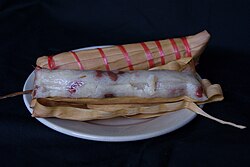This article needs additional citations for verification .(July 2014) |
 Lepet, sticky rice dumpling with peanuts cooked in coconut milk | |
| Alternative names | Leupeut (Sundanese), Lepat (Malay) |
|---|---|
| Type | Dumpling |
| Region or state | Java, Indonesia |
| Main ingredients | Sticky rice, coconut milk, peanuts, wrapped in young coconut leaf |
Lepet (Javanese), Leupeut (Sundanese), or Lepat (Indonesian) is a type of steamed sticky rice dumpling snack found among peoples throughout Java (Javanese and Sundanese), Sumatra and the Malay Peninsula (Malay). The pudding is packed inside a janur (young coconut leaf) or palm leaf. It is similar to lontong, but with a stickier texture and richer flavor due to the use of coconut milk and peanuts.
